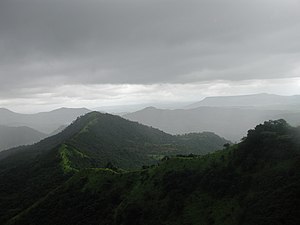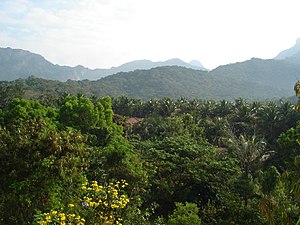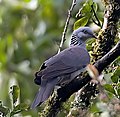Lakes and reservoirs[edit]
The Western Ghats have several manmade lakes and reservoirs. The well known lakes are the Ooty (2500 m altitude, 34.0 ha) in Nilgiris, and the Kodaikanal (2285 m, 26 ha) and the Berijam in the Palani Hills. The Pookode lake of Wayanad in Kerala at Lakkadi is a beautiful scenic one with boating and garden arrangements. Most of the bigger lakes are situated in the state of Tamil Nadu. Two smaller lakes, theDevikulam (6.0 ha) and the Letchmi Elephant (2.0 ha) are in the Munnar range.
The majority of streams draining the Western Ghats and joining the Rivers Krishna and Kaveri carry water during monsoon months only and have been dammed for hydroelectric and irrigation purposes. The major reservoirs are: Lonavala and Walwahn in Maharashtra; V.V. Sagar, K.R. Sagar and Tungabhadra in the Malenadu area of Karnataka; Mettur Dam, Upper Bhavani, Mukurthi, Parson's Valley, Porthumund, Avalanche, Emerald, Pykara, Sandynulla, Karaiyar, Servalar, Kodaiyar, Manimuthar Dam and Glenmorgan in Tamil Nadu; and Kundallay and Maddupatty in the High Range of Kerala. Of these the Lonavla, Walwahn, Upper Bhavani, Mukurthi, Parson's Valley, Porthumund, Avalanche, Emerald, Pykara, Sandynulla, Glenmorgan, Kundally and Madupatty are important for their commercial and sport fisheries for trout, mahseer and common carp.[15]
Rivers[edit]
The Western Ghats form one of the four watersheds of India, feeding the perennial rivers of India. Important rivers include the Godavari,Krishna and Kaveri. These rivers flow to the east and drain out into the Bay of Bengal. The west flowing rivers, that drain into the Arabian Sea and the Laccadive Sea, are fast-moving, owing to the short distance travelled and steeper gradient. Important rivers include thePeriyar, Bharathappuzha, Netravati, Sharavathi, Mandovi and Zuari. Many of these rivers feed the backwaters of Kerala and Maharashtra. Rivers that flow eastwards of the Ghats drain into the Bay of Bengal. These are comparatively slower moving and eventually merge into larger rivers such as the Kaveri and Krishna. The larger tributaries include the Tunga River, Bhadra river, Bhima River, Malaprabha River,Ghataprabha River, Hemavathi river, Kabini River. In addition there are several smaller rivers such as the Chittar River, Manimuthar River,Kallayi River, Kundali River and the Pachaiyar River.
Fast running rivers and steep slopes have provided sites for many large hydro-electric projects. There are about 50 major dams along the length of the Western Ghats with the earliest project up in 1900 near Khopoli in Maharashtra.[16] Most notable of these projects are theKoyna Hydroelectric Project in Maharashtra, the Parambikulam Dam in Kerala, and the Linganmakki Dam in Karnataka.[10] The reservoir behind the Koyna Dam, the Shivajisagar Lake, has a length of 50 km (31 mi) and depth of 80 m (262 ft).[17] It is the largest hydroelectric project in Maharashtra, generating 1,920 MW of electric power.[18] Another major Hydro Electric project is Idukki dam in Kerala. This dam is one of the biggest in Asia and generates around 70% of power for Kerala state. Mullai Periyar dam near Thekkady is one of the oldest in the world and a major tourist attractions in Kerala. Water from this dam is drawn to the vast coastal plain of Tamil Nadu, forming a delta and making it rich in vegetation.
During the monsoon season, numerous streams fed by incessant rain drain off the mountain sides leading to numerous and often spectacular waterfalls. Among the most well known is the Jog Falls, Kunchikal Falls, Dudhsagar Falls, Sivasamudram Falls, and Unchalli Falls. The Jog Falls is the highest natural plunge waterfall in South Asia and is listed among the 1001 natural wonders of the world.[19]Talakaveri wildlife sanctuary is a critical watershed and the source of the river Kaveri. This region has dense evergreen and semi-evergreen vegetation, with shola-grassland in areas of higher elevation. The steep terrain of the area has resulted in scenic waterfalls along its many mountain streams. Sharavathi and Someshvara Wildlife sanctuaries in Shimoga district are the source of the Tungabhadra River system.The Netravathi river has also its origin at western ghats of India flowing westwards to join Arabian sea at Mangalore.
Climate[edit]
Climate in the Western Ghats varies with altitudinal gradation and distance from the equator. The climate is humid and tropical in the lower reaches tempered by the proximity to the sea. Elevations of 1,500 m (4,921 ft) and above in the north and 2,000 m (6,562 ft) and above in the south have a more temperate climate. Average annual temperature here are around 15 °C (60 °F). In some parts frost is common, and temperatures touch the freezing point during the winter months. Mean temperature range from 20 °C (68 °F) in the south to 24 °C (75 °F) in the north. It has also been observed that the coldest periods in the south western ghats coincide with the wettest.[20]
During the monsoon season between June and September, the unbroken Western Ghats chain acts as a barrier to the moisture laden clouds. The heavy, eastward-moving rain-bearing clouds are forced to rise and in the process deposit most of their rain on the windward side. Rainfall in this region averages 3,000–4,000 mm (120–160 in) with localised extremes touching 9,000 mm (350 in). The eastern region of the Western Ghats which lie in the rain shadow, receive far less rainfall averaging about 1,000 mm (40 in) bringing the average rainfall figure to 2,500 mm (150 in). Data from rainfall figures reveal that there is no relationship between the total amount of rain received and the spread of the area. Some areas to the north in Maharashtra while receiving heavier rainfall are followed by long dry spells, while regions closer to the equator receiving less annual rainfall, have rain spells lasting almost the entire year.[20]
Ecoregions[edit]
The Western Ghats are home to four tropical and subtropical moist broadleaf forest ecoregions – the North Western Ghats moist deciduous forests, North Western Ghats montane rain forests, South Western Ghats moist deciduous forests, and South Western Ghats montane rain forests.
The northern portion of the range is generally drier than the southern portion, and at lower elevations makes up the North Western Ghats moist deciduous forests ecoregion, with mostly deciduous forests made up predominantly of teak. Above 1,000 meters elevation are the cooler and wetter North Western Ghats montane rain forests, whose evergreen forests are characterised by trees of family Lauraceae.
The evergreen Wayanad forests of Kerala mark the transition zone between the northern and southern ecologic regions of the Western Ghats. The southern ecologic regions are generally wetter and more species-rich. At lower elevations are the South Western Ghats moist deciduous forests, with Cullenia the characteristic tree genus, accompanied by teak, dipterocarps, and other trees. The moist forests transition to the drier South Deccan Plateau dry deciduous forests, which lie in its rain shadow to the east.
Above 1,000 meters are the South Western Ghats montane rain forests, also cooler and wetter than the surrounding lowland forests, and dominated by evergreen trees, although some montane grasslands and stunted forests can be found at the highest elevations. The South Western Ghats montane rain forests are the most species-rich ecologic region in peninsular India; eighty percent of the flowering plantspecies of the entire Western Ghats range are found in this ecologic region.
Biodiversity protection[edit]
Historically the Western Ghats were well-covered in dense forests that provided wild foods and natural habitats for native tribal people. Its inaccessibility made it difficult for people from the plains to cultivate the land and build settlements. After the arrival of the British in the area, large swathes of territory were cleared for agricultural plantations and timber. The forest in the Western Ghats has been severely fragmented due to human activities, especially clear felling for tea, coffee, and teak plantations during 1860 to 1950. Species that are rare, endemic and habitat specialists are more adversely affected and tend to be lost faster than other species. Complex and species rich habitats like the tropical rainforest are much more adversely affected than other habitats. [21]
The area is ecologically sensitive to development and was declared an ecological hotspot in 1988 through the efforts of ecologist Norman Myers. Though this area covers barely five percent of India's land, 27% of all species of higher plants in India (4,000 of 15,000 species) are found here. Almost 1,800 of these are endemic to the region. The range is home to at least 84 amphibian species, 16 bird species, seven mammals, and 1,600 flowering plants which are not found elsewhere in the world.
The Government of India established many protected areas including 2 biosphere reserves, 13 National parks to restrict human access, several wildlife sanctuaries to protect specific endangered species and many Reserve Forests, which are all managed by the forest departments of their respective state to preserve some of the ecoregions still undeveloped. Many National Parks were initially Wildlife Sanctuaries. The Nilgiri Biosphere Reserve comprising 5500 km² of the evergreen forests of Nagarahole, deciduous forests of Bandipur National Park and Nugu in Karnataka and adjoining regions of Wayanad, Mudumalai National Park and Mukurthi National Park in the states of Kerala and Tamil Nadu forms the largest contiguous protected area in the Western Ghats.[22] The Western Ghats is home to numerous serene hill stations like Munnar, Ponmudi and Waynad. The Silent Valley National Park in Kerala is among the last tracts of virgin tropical evergreen forest in India.[23]
Regarding the Western Ghats, in November 2009, Minister of Environment and Forests, Jairam Ramesh said,
"The Western Ghats has to be made an "ecologically sensitive zone". It is as important as the ecological system of the Himalayas for protection of the environment and climate of the country. The Central government will not give sanction for mining and hydroelectric projects proposed by the State Governments of Maharashtra, Karnataka and Goa that will destroy the Western Ghatseco-system.’’[24]
In a letter dated 20 June 2009, Mr. Ramesh said,
“The (proposed) 200-MW Gundia hydel project of Karnataka Power Corporation in Hassan district would drown almost 1,900 acres (7.7 km2) of thick forest in the already endangered Western Ghats along with all its fauna. This is something that both Karnataka and our country can ill-afford." "Power generation should not happen at the cost of ecological security."
The Expert Appraisal Committee appointed by Union Government also said that the project should not be taken up.[25]
In August, 2011, the Western Ghats Ecology Expert Panel (WGEEP) designated the entire Western Ghats as an Ecologically Sensitive Area (ESA) and, assigned three levels of Ecological Sensitivity to its different regions.[26]
UNESCO World Heritage Site[edit]
In 2006, India applied to the UNESCO MAB for the Western Ghats to be listed as a protected World Heritage Site.[27] In 2012 following 39 places are declared as World Heritage Sites:[28][29]
- Kalakkad Mundanthurai Tiger Reserve
- Shendurney Wildlife Sanctuary
- Neyyar Wildlife Sanctuary
- Peppara Wildlife Sanctuary
- Kulathupuzha Range
- Palode Range
- Periyar Tiger Reserve
- Ranni Forest Division
- Konni Forest Division
- Achankovil Forest Division
- Srivilliputtur Wildlife Sanctuary
- Tirunelveli (North) Forest Division (part)
- Eravikulam National Park (and proposed extension)
- Grass Hills National Park
- Karian Shola National Park
- Karian Shola (part of Parambikulam Wildlife Sanctuary)
- Mankulam Range
- Chinnar Wildlife Sanctuary
- Mannavan Shola
- Silent Valley National Park
- New Amarambalam Reserved Forest
- Mukurthi National Park
- Kalikavu Range
- Attapadi Reserved Forest
- Pushpagiri Wildlife Sanctuary
- Brahmagiri Wildlife Sanctuary
- Talacauvery Wildlife Sanctuary
- Padinalknad Reserved Forest
- Kerti Reserved Forest
- Aralam Wildlife Sanctuary
- Kudremukh National Park
- Someshwara Wildlife Sanctuary
- Someshwara Reserved Forest
- Agumbe Reserved Forest
- Balahalli Reserved Forest
- Kaas Plateau
- Koyna Wildlife Sanctuary
- Chandoli National Park
- Radhanagari Wildlife Sanctuary
Fauna[edit]
The Western Ghats are home to thousands of animal species including at least 325 globally threatened species. Many are endemicspecies, especially in the amphibian and reptilian classes. Thirty two threatened species of mammals live in the Western Ghats. Of the 16 endemic mammals, 13 are threatened [30]
- Mammals- There are at least 139 mammal species. A critically endangered mammal of the Western Ghats is the nocturnal Malabar large-spotted civet. The arboreal Lion-tailed macaque is endangered. Only 2500 of this species are remaining.[31] The largest population of Lion tailed macacque is in Silent Valley National Park. Kudremukh National Park also protects a viable population.[32]
- These hill ranges serve as important wildlife corridors, allowing seasonal migration of endangered Asian elephants. The Nilgiri Bio-sphere is home to the largest population of Asian Elephants and forms an important Project Elephant and Project Tiger reserve.Brahmagiri and Pushpagiri wildlife sanctuaries are important elephant habitats. Karnataka's Ghat areas hold over six thousand elephants (as of 2004) and ten percent of India's critically endangered tiger population.[33]
- The largest population of India's tigers outside the Sundarbans is in the unbroken forests bordering Karnataka, Tamil Nadu and Kerala. The largest numbers and herds of vulnerable gaur are found here with the Bandipur National Park and Nagarhole together holding over five thousand Gaur.[34] To the west the forests of Kodagu hold sizeable populations of the endangered Nilgiri langur.
- Bhadra Wildlife Sanctuary and project tiger reserve in Lakkavalli of Chikmagalur has large populations of Indian muntjac. Many Asian elephant, gaur, sambar, vulnerable sloth bears, leopard, tiger and wild boars dwell in the forests of Karnataka.
- Bannerghatta National Park and Annekal reserve forest is an important elephant corridor connecting the forests of Tamil Nadu with those of Karnataka. Dandeli and Anshi national parks in Uttara Kannada district are home to the black panther and normal variety ofleopards and significant populations of Great Indian Hornbill. Bhimgad in Belgaum district is a proposed wildlife sanctuary and is home to the endemic critically endangered Wroughton's freetailed bat. the Krishnapur caves close by are one of only three places in the country where the little-known Theobald's tomb bat is found. Large Lesser False Vampire bats are found in the Talevadi caves.[35]
- Reptiles- The snake family Uropeltidae of the reptile class is almost entirely restricted to this region.
- Amphibians- The amphibians of the Western Ghats are diverse and unique, with more than 80% of the 179 amphibian species being endemic to the region. Most of the endemic species have their distribution in the rainforests of these mountains.[36] The endangeredPurple frog was discovered in 2003 to be a living fossil. This species of frog is most closely related to species found in the Seychelles. Four new species of Anurans belonging to the genus Rhacophorus, Polypedates, Philautus and Bufo have been described from the Western Ghats.[37]
- Fish – 102 species of fish are listed for the Western Ghats water bodies.[15] Western Ghats streams are home to several brilliantly coloured ornamental fishes like Red line torpedo barb, Red-tailed barb,[38] Osteobrama bakeri, Günther's catfish and freshwater puffer fish Tetraodon travancoricus, Carinotetraodon imitator and marine forms like Chelonodon patoca (Buchanan-Hamilton, 1822);[39]mahseers such as Malabar mahseer.[40]
- Birds- There are at least 508 bird species. Most of Karnataka's five hundred species of birds[41] are from the Western Ghats region.[42]Bhadra Wildlife Sanctuary is located at the northern end of the Malabar ranges and the southern tip of the Sahyadri ranges and bird species from both ranges can be seen here.
- There are at least 16 species of birds endemic to the western Ghats including the endangered Rufous-breasted Laughingthrush, the vulnerable Nilgiri Wood-pigeon, White-bellied Shortwing and Broad-tailed Grassbird, the near threatened, Grey-breasted Laughingthrush, Black-and-rufous Flycatcher, Nilgiri Flycatcher, and Nilgiri Pipit and the least concern Malabar Parakeet, Malabar Grey Hornbill, White-bellied Treepie, Grey-headed Bulbul, Rufous Babbler, Wynaad Laughingthrush, White-bellied Blue-flycatchers and the Crimson-backed Sunbird.[43]
- Insects- There are roughly 6,000 insect species from Kerala alone.[44] Of 334 butterfly species recorded from the Western Ghats, 316 species have been reported from the Nilgiri Biosphere Reserve.[45]
- Molluscs- Seasonal rainfall patterns of the Western Ghats necessitate a period of dormancy for its land snails, resulting in their high abundance and diversity including at least 258 species ofgastropods from 57 genera and 24 families.[46]


































No comments:
Post a Comment